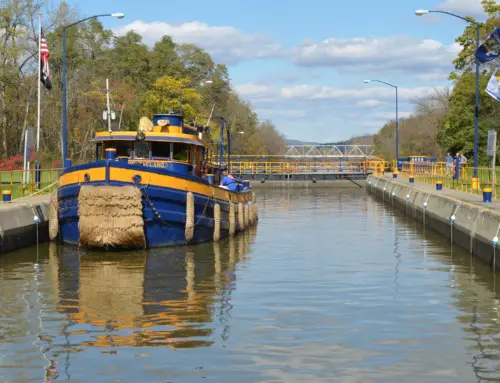The year was 1841, and the United States faced another possible threat from Great Britain, the same nation from whom it had won freedom only 65 years ago, and who tried again to retake it 28 years prior. In August of this year, Congress appropriated hundreds of dollars to build a chain of forts from the East Coast to the Minnesota Territory. One of these forts, Fort Wayne was built at Detroit, and through the years, has played a part in many events in United States history.
In the 1830s, British Canada saw a series of small, short-lived rebellions. Canadians were protesting corruption in its colonial government, and these attacks became known as the Patriot War. Americans heard about these attacks and raised volunteer militia groups to help the Canadians out. However, the United States government wanted to remain officially neutral in this conflict to the north. Because of that, they sent U.S. troops to suppress the American militias. While there, the federal government realized just how vulnerable the northern border was to potential attack from the British, and went to work on a way to remedy that problem. Fort Wayne, along with many other forts, is a result of this.
Montgomery C. Meigis played a major role in the early days of Fort Wayne. Meigis was a career United States Army officer and civil engineer, who later served as Quartermaster General of the U.S. Army during and after the American Civil War. In 1842, however, he was sent to oversee construction of the fort in Detroit. Fort Wayne would be the third fort built in the area, but was the first one built by Americans. Previous forts were Fort Pontchartrain du Detroit, built by the French in 1701, and the British Fort Lernoult, which stood from 1760 until 1796. Fort Wayne was built at the point on the shores of the Detroit river that was closest to British Canada, and was a five-point fort composed of cedar and earthen walls. It was to be an artillery post that would boast the most up-to-date cannon capable of reaching the Canadian shore. Fort Wayne was completed in 1851, then named after Revolutionary War hero Anthony Wayne.
Before Fort Wayne was fully armored, the United States and Great Britain resolved their differences and signed the Webster–Ashburton Treaty, which settled the boundary disputes between the U.S. and British Canada. The fort remained intact, but was unused for a decade. During that time, only a single watchman oversaw it. As time passed, it played a small role in almost every major event in U.S. history. It is also interesting to note that an Irish farmer who lived nearby operated a small ferry to Canada, and this, along with other evidence, suggests Fort Wayne was a stop on the Underground Railroad.
In 1861, the United States was being torn apart by war. Though Michigan was far from actual combat, British sympathy for the South renewed fears that there might be an attack from Canada. Fort Wayne was strengthened, and the 1st Michigan Volunteer Regiment was mustered into service there just two weeks after the war began. From then on, the fort was a mustering center for Michigan troops before heading to the front. It also became a haven for veterans to recover after being wounded in the conflict.
As stated, the fort was unused for many years, so there were no commanders until after the start of the Civil War. The first commander of the fort was Alfred Fibbs, who had been captured early in the war by the Confederates and served his parole at Fort Wayne. During the earlier years of the Civil War, neither side had a means for dealing with large numbers of prisoners. Because of this, they turned to a European system of parole and exchange of prisoners. Prisoners would give their word not to take up arms against their captors until they were formally exchanged for an enemy captive of equal rank. It was a practice that ended by 1863.
After the war ended, Fort Wayne continued to be used. Between 1865 and 1920, it was a garrison post, mostly consisting of regiments rotating in from the western frontier. The Spanish-American War began as the 19th Century came to an end, and troops who mustered in at Fort Wayne headed to Cuba and the Philippines. It was also during this time that the fort’s guardhouse housed the first telephone exchange in Southwest Detroit.
By the time the United States entered World War I, Fort Wayne had become instrumental in the logistics of the American military. They were largely responsible for obtaining and moving cars, trucks and spare parts to where they were needed. After World War I and the Bolshevik Revolution in Russia, many Americans feared the possibility of Communism taking over the United States. Many suspected communists were arrested, and Fort Wayne became a temporary detention center for these individuals.
Fort Wayne not only saw military innovations, but also civilian accomplishments. In 1921, the world’s first motorized ride-on lawn mower was used on the ground. Fort Wayne was promoting the invention, which had been patented by Ransom E. Olds and produced by the Ideal Power Mower Co. of Lansing. In 1922, it was the temporary home of the U.S. Army Chaplain School, which was created out of a need to adequately train chaplains to staff the U.S. Army. Even during our country’s low points, Fort Wayne played a role. During the Great Depression, the fort was open to homeless families, and also housed the Civilian Conservation Corps.
Throughout the 1930s, Fort Wayne continued as a motor vehicle supply station. With the start of World War II, it was designated an official Motor Supply Depot and additional buildings were built for storage and shipping. It became the largest motor supply depot in the world. Detroit had many factories, especially in the automobile industry. Fort Wayne controlled the flow of materials from these businesses to other storage and staging facilities, then on to the World War II fronts. At this time, the fort employed over 2,000 workers, mostly civilian women. There were also men being trained for various wartime jobs.
Not only was Fort Wayne a cog in the logistics of World War II, it also served as a place to keep Italian prisoners of war that had been captured during the North African campaign. These men were used as servants, cooks and janitors at the fort. After Italy surrendered in September of 1943, these Prisoners of War were given the choice of returning to Italy, but many of them chose to settle in Detroit.
The end of World War II was the beginning of the end for Fort Wayne’s military uses. In 1948, the fort and its original barracks were turned over to the City of Detroit’s Historical Commission to operate as a military museum, but it was still used at certain times for military activity. In the 1950s anti-aircraft guns were installed at the fort, and during the Cold War, it served as an entrance station for the armed forces. Thousands of enlistees and draftees were sworn in during the Korean and Vietnam Wars. It was also used from 1967 until 1971 to provide housing for families that had been displaced during the 12th Street Riot, which was a series of confrontations between black residents of Detroit and the Detroit Police Department.
Fort Wayne, though no longer an active fort, is still very much in use. Today, you can visit the original 1848 limestone barracks building, the 1845 star-fort, which was renovated in 1861, the restored Commanding Officer’s office, and the Spanish-American guard house. The grounds are also home to the Tuskegee Airmen National Historic Museum and Native American burial site. Fort Wayne hosts historic reenactments, flea markets, concerts, soccer leagues, and more. In addition, the Historic Fort Wayne Coalition has many plans in the works to preserve and return Fort Wayne to prominence in the future. This fort has a long and fascinating history and continues to be a great place to learn about our nation’s past. Be sure to stop in for a visit.







Leave A Comment
You must be logged in to post a comment.